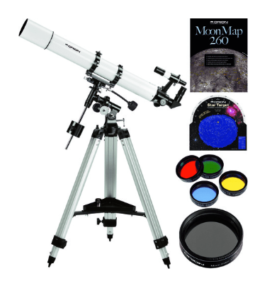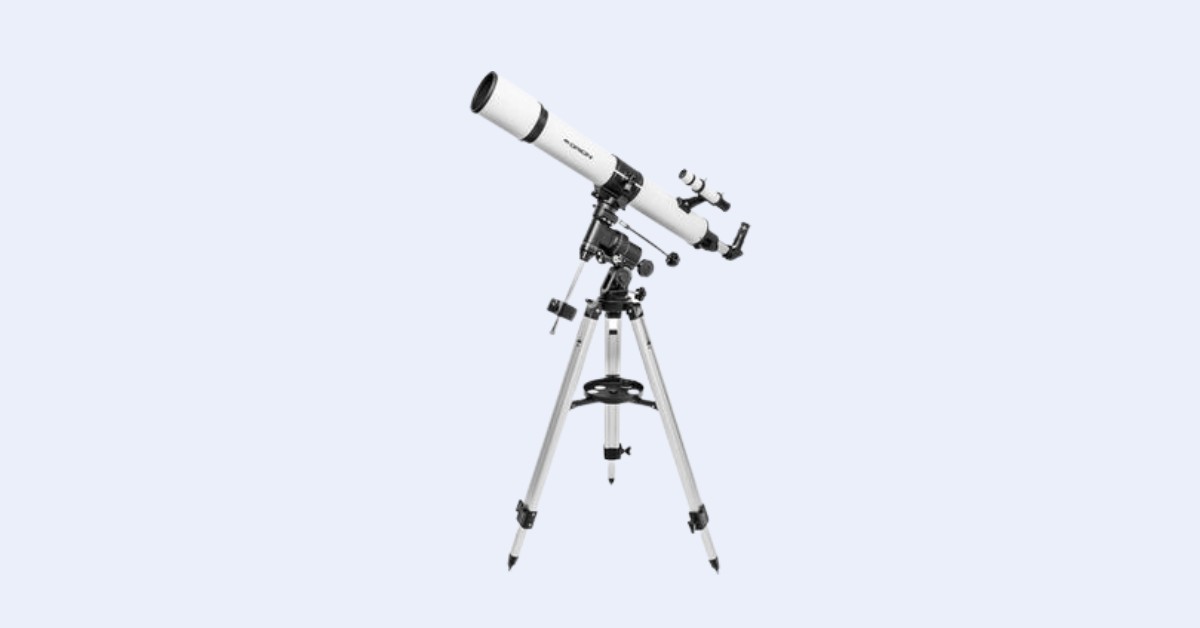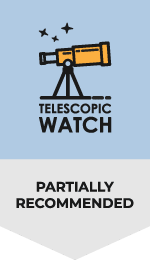The Optical Tube Performance Of Observer 90mm

The AstroView 90, which was recently renamed the Observer 90, is a 90mm f/10.1 achromatic doublet with crown and flint glass in the standard Fraunhofer configuration. Because it has a focal ratio of f/10.1, it has some chromatic aberration that is easy to see, but not enough to change the sharpness of the views in a measurable way.
The optics in the Observer 90 are exceptionally good – a cut above a lot of the cheap achromatic refractors. I have been impressed by the views through these scopes. The Observer 90 is also well-baffled and has decent interior paint, along with an ample-length dew shield. Stray light and glare are not issues.
The focuser on the Observer 90 is a 1.25” rack and pinion unit made largely of metal, but with plastic knobs. I don’t like these knobs because they kind of dig into your fingers, but they continue to persist on a lot of scopes for whatever reason. The OTA has absolutely zero plastic parts besides these knobs.
Like a lot of equatorially mounted inexpensive scopes, the Observer 90 has a captive ¼ 20 threaded knob on one of the rings to allow for piggybacking a DSLR camera. Forget using this, though, because the EQ2 mount supplied with the scope cannot handle the weight of a DSLR added on top of the scope.
About the Accessories
The Observer 90 comes with two eyepieces: a 25mm Plossl supplying 36x and a 10mm Plossl supplying 91x, both branded as part of Orion’s “Sirius” line (in reality, they are identical to pretty much every good Chinese or Taiwanese Plossl sold on the market, as all are made in the same one or two factories). These are of high quality and you don’t need to really replace them, but a 6mm “gold-line” will allow you to get the most magnification the scope can handle, and a 32mm Plossl will allow for a slightly wider field of view and lower magnification than the 25mm.
The Observer 90 has an inexpensive 6×30 finderscope. This does work, but it is often uncomfortable to look through and doesn’t have particularly bright images. A red dot would’ve been preferable, as you really don’t need anything more for a 90mm telescope targeted at beginners.
The Observer 90’s star diagonal is a metal, regular 90-degree prism unit which is of high quality, unlike the cheap, plastic Amici prism diagonals supplied with a lot of cheap refractors meant to allow for terrestrial viewing, which produce a fuzzy image and diffraction spikes on bright objects.
How Good Is The EQ2 Mount?
The Observer 90 comes with an EQ2 mount that is pretty standard and that Orion just calls the EQ2. The EQ2 mount is adequate for a 90mm f/10 refractor, but it is definitely on the lean side. It really has no extra capacity for piggybacking a camera.
The Observer 90 optical tube and EQ2 lack any sort of dovetail system—the rings bolt directly to the mount. As a result, dismantling and transporting the scope is a bit of a pain because either a) you have to leave the rings on, or b) you have to dismantle it using tools. Neither option is particularly convenient nor appealing.
The EQ2’s tripod is thin-walled extruded aluminum, designed to be as lightweight as possible. Unfortunately, this stuff tends to be flimsy and easily damaged. The tripod also has a lot of plastic components, adding to the overall flimsy feel.
The mount head is all metal and comes with flexible slow-motion control knobs, and I like it. It just feels (and in fact, simply is) a little small for the 90mm refractor optical tube.
The EQ2 mount can be upgraded with a single-axis or dual-axis motor drive for hands-free battery-powered tracking, but its limited extra weight capacity means there is no way you can piggyback a camera on top of the OTA.
Should I buy a Used Observer 90?
Personally, I would say that absolutely! There’s little to go wrong with a used manual refractor.
Alternative Recommendations
The Observer 90 is far from a good deal for the price, though it’s at least an acceptable telescope.
Under $300
- The Zhumell Z100 and Orion SkyScanner 100mm provide a similar amount of light-gathering ability and equally sharp planetary views to the Observer 90 but with a much wider field of view more suitable for observing deep-sky objects and making aiming easier, and the tabletop Dobsonian mount is a lot less confusing to use than the spindly EQ-1 equatorial mount.
- The Zhumell Z114 and Orion StarBlast 4.5 Astro both offer significantly more light gathering ability than the Observer 90 and a vastly wider field of view, along with easier-to-use Dobsonian mounts and well-made accessories included.
- The Sky-Watcher Heritage 130P provides significantly brighter and sharper views than the Observer 90 along with a wider field of view, superior mount, and an ultra-portable collapsible tube design.
$300-$500
- The Popular Science by Celestron StarSense Explorer DX 100AZ is our favorite pick if you absolutely insist on a refractor over a reflector. It has more chromatic aberration than the Observer 90, but a wider field of view, more aperture, and a significantly better and simpler alt-azimuth mount. The DX 100AZ also uses Celestron’s StarSense Explorer technology to allow your smartphone to assist in aiming it at targets.
- The Sky-Watcher Heritage 150P offers nearly triple the light gathering power of the Observer 90 and nearly double the resolution, all in an extremely compact and portable form factor with a simple Dobsonian mounting and well-designed accessories. The computerized Virtuoso GTi 150P is identical to the Heritage but adds full motorized tracking and GoTo technology controlled with your smartphone or tablet.
- The Orion SkyQuest XT6 isn’t the most portable, but stands on its own full-sized Dobsonian base without a tripod or table and provides great views typical of 6” of aperture with a heavy-duty 2” single-speed Crayford focuser, sharp optics, and decent included accessories. Other 6” f/8 Dobsonians provide similar features, though the 2” Crayford focuser is somewhat unique to the SkyQuest XT6.
Aftermarket Accessory Recommendations
The only significant accessory we think is necessary for the Observer is a 6mm “goldline” for 150x magnification, which is about the limit that the telescope is capable of. You could perhaps buy a 32mm Plossl to squeeze just a bit more of a field of view out of the telescope and slightly lower magnification (28x), but it’s doubtful how much you really need it. Lastly, Orion sells a motor drive for hands-free, automatic tracking and push-button slow motion on the right ascension axis. Whether you need this is up to you.
Observing
Where the Observer 90 really excels is on the Moon, planets, and double stars. It’s able to split doubles as close as 1.3 arcseconds apart and show lunar details as small as 3 miles across. The phases of Mercury and Venus are no problem, and you should be able to see the ice caps and dark shading on Mars when it’s close to Earth for a few months out of every 2 years. The Observer will also have no problem revealing Jupiter’s cloud belts, Great Red Spots, and 4 large moons – and you might just be able to make out their tiny disks and shadows as they transit and eclipse the planet. You can see Saturn’s rings and a few of its moons. If you look closely, you might be able to see the Cassini Division inside the rings and maybe the low-contrast cloud banding on Saturn itself. Uranus and Neptune will be dim, hard-to-find starlike dots with hints of bluish coloring.
The Observer 90 can show you a fair amount of star clusters, a handful of galaxies, and of course the Orion Nebula. Just don’t get your expectations too high about any deep-sky views, as most objects are going to appear fuzzy and dim, particularly due to the scope’s small aperture.
As to astrophotography, the scope’s small size, long focal ratio, and somewhat undersized mount limit you to smartphone shots of the Moon and maybe the planets.




I just received this telescope and haven’t had a chance to use it yet. Thanks for your informative review.
Where can I get a better focuser for my Orion 90mm explorer the one that came with it is all plastic also would like metal scope rings